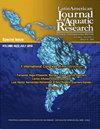美国沼虾(Bate, 1868)成虾体温调节过程中的最大临界温度和耗氧量
IF 0.8
4区 农林科学
Q3 FISHERIES
Latin American Journal of Aquatic Research
Pub Date : 2022-05-01
DOI:10.3856/vol50-issue2-fulltext-2824
引用次数: 2
摘要
美洲巨臂虾是一种生活在美洲太平洋一侧热带和亚热带生态系统的河流和沿海水体中的大型对虾。水温和盐度是决定其分布的主要物化变量。温度也影响其代谢率,代谢率决定生长速度和繁殖。因此,对野生对虾在4种温度(20、24、28和32℃)下的首选温度、临界热最大值(CTMax)和氧气消耗率进行了实验室检测。这些温度与采样地点的年温度波动相对应。该物种的最终偏好温度接近26.4°C。驯化温度对CTMax的影响呈近似线性关系(R2 = 0.987, P < 0.05),在驯化温度为20 ~ 32℃的范围内,随驯化温度的升高,常规耗氧量增加。本文章由计算机程序翻译,如有差异,请以英文原文为准。
Maximum critical temperature and oxygen consumption during thermoregulation in Macrobrachium americanum (Bate, 1868) adult prawns
Macrobrachium americanum is a large prawn living in rivers and coastal water bodies of tropical and subtropical ecosystems of the Pacific side of the Americas. Water temperature and salinity are the main physicochemical variables determining its distribution. Temperature also influences its metabolic rate, which determines growth rate and reproduction. Because of this, preferred temperature, critical thermal maximum (CTMax), and O2 consumption rates at four temperatures (20, 24, 28, and 32°C) were tested from wild prawns in laboratory assays. Those temperatures correspond to the annual temperature fluctuations at the sampling site. The final preferred temperature of this species is close to 26.4°C. The acclimatization temperature has an almost linear effect on the CTMax (R2 = 0.987, P < 0.05), and the oxygen consumption routine rates increased as the acclimation temperature increased from 20 to 32°C.
求助全文
通过发布文献求助,成功后即可免费获取论文全文。
去求助
来源期刊

Latin American Journal of Aquatic Research
FISHERIES-MARINE & FRESHWATER BIOLOGY
CiteScore
1.70
自引率
10.00%
发文量
44
审稿时长
4-8 weeks
期刊介绍:
Latin American Journal of Aquatic Research- LAJAR is the continuation of the journal Investigaciones Marinas (1970-2007) and is published since 2008 by the Escuela de Ciencias del Mar, Facultad de Ciencias del Mar y Geografía of the Pontificia Universidad Católica de Valparaíso. LAJAR is an “Open Access” journal that publishes in English language, original research articles, reviews and short communications on aquatic science, which contain the results of research conducted in aquaculture or in oceanic and coastal marine waters of Latin America.
The following topics are considered: Physical Oceanography, Chemical Oceanography, Marine Biogeochemistry, Marine Pollution and Toxicology, Marine Geology and Geophysics, Biological Oceanography, Fisheries and Aquaculture.
 求助内容:
求助内容: 应助结果提醒方式:
应助结果提醒方式:


